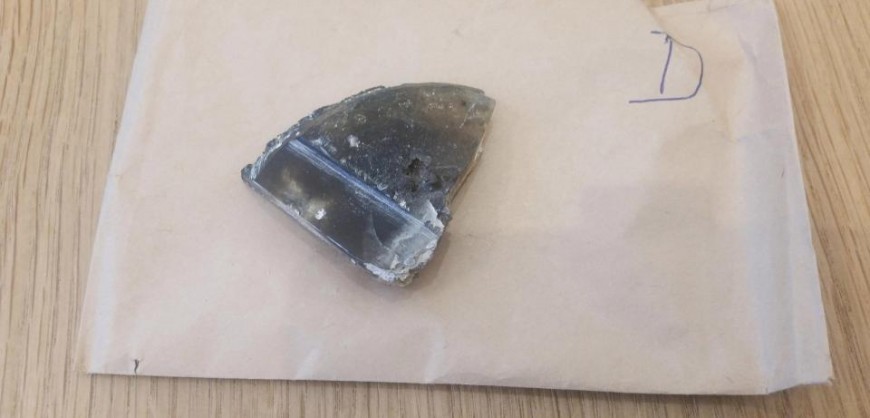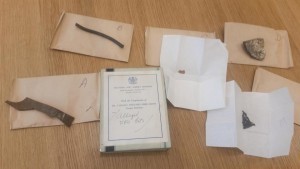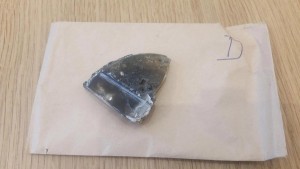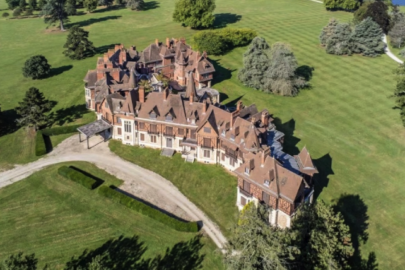The missing wreckage of “Britain’s Roswell” has been discovered stored in a cigarette tin and kept in a storage room in a London museum.
The remnants are thought to be part of a UFO that reportedly crash-landed 60 years ago in the UK.
(Pieces said to be from the wreckage of the Silpho UFO found in 1957)
British UFO enthusiasts believed the remains, supposedly part of the Silpho UFO found in 1957, were either on display in a local fish and chip shop or had ended up on a scrap heap.
In reality, the remains had been sent to the Science Museum in the capital for expert examination in 1963.
The apparent ‘flying saucer’ was believed to be 45cm in diameter and weighed 15kg and was found by three men on Silpho Moor, near Scarborough in November 1957, just a few months after Russia launched its Sputnik spacecraft.
The copper base of the object was said to be inscribed with hieroglyphs, apparently similar to the wreckage of the UFO which ‘crashed’ at Roswell, New Mexico in June 1947.
(A piece of the wreckage said to be from a UFO that crash-landed on Silpho Moor)
When the object was cut open a book made of 17 think copper sheets was found inside, with each sheet covered in more hieroglyphs.
Local café owner Phillip Longbottom claimed the hieroglyphs translated into a 2000-word message sent by an alien called Ullo, which contained a warning of ‘You will improve or disappear.’
After the remains of the UFO were sent to London for testing they were passed to Gordon Claringbull, who specialized in meteorites and explosives, at the Natural History Museum.
Mr Claringbull claimed he could not find anything unusual in the samples and some skeptics claimed the ‘saucer’ was made from a domestic hot water cylinder in a back-street garage and planted on the moor as an elaborate hoax.
Tests carried out at Manchester University revealed the object’s shell contained lead and the copper parts were of unusual high purity.
However, a metallurgist concluded it could not have arrived on Earth from space as there was no evidence it had been exposed to high temperatures.
Air Chief Marshal Lord Dowding, who believed that the object was extra-terrestrial, revealed in 1959 that he had “actually held and examined” the Silpho object and he described it as “a miniature pilot flying saucer”.
Andy Roberts, former editor of UFO Brigantia magazine, said the Silpho Saucer story was Britain’s answer to Roswell incident, in which a crashed ‘flying saucer’ was allegedly spirited away from a ranch in New Mexico in 1947.
Mr Roberts: “This is an amazing breakthrough. It’s incredible to hear that all this time pieces of this mystery object have been sitting in a museum archive.”

(A contemporary news report on the Silpho Moor find)
Scarborough businessman Frank Dickenson, then 42, found the saucer along with two of his friends after his car stalled and they spotted a glowing object in the sky that appeared to fall to the ground.
He found the metallic saucer lying in a patch of bracken and returned to his car to tell his friends, when they made their way back to the wreckage it was gone.
Mr Dickenson was desperate to find the wreckage and placed an advert in the local paper and a man came forward and sold it to Frank for £10.
After buying the wreckage back Mr Dickenson, Anthony Parker and Phillip Longbottom forced the object open to find traces of ash, glass and the copper book inside.
Dr David Clarke of Sheffield Hallam University, who has a PhD in British folklore and cultural tradition, was invited to see the remains at The Science Museum after he gave a talk there on his work for The National Archives on the release of the Ministry of Defence’s UFO files.
“One of the museum staff tapped me on the shoulder and asked if I was aware that ‘bits of a flying saucer’ had been kept in a cigarette tin in the museum group store for decades.
“I was absolutely amazed when later we opened the tin box and saw the wreckage. It was obvious these were the remains of the missing Silpho Saucer that some have claimed as Britain’s answer to the famous Roswell incident.
‘It’s incredible to hear that pieces of this mystery object have been sitting in a museum archive for more than half a century”.
Source: thesun



































